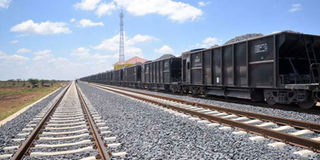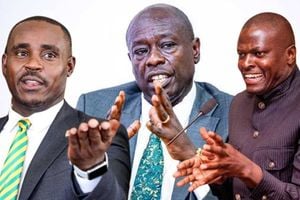Petitioner stops Uhuru’s railway project over unpaid Sh1.4 billion

A section of the standard gauge railway crossing in Makueni County on March 17, 2016. A section of the Sh327 railway project has been halted by the High Court in a land compensation dispute pitting the government against land owners. PHOTO | SALATON NJAU | NATION MEDIA GROUP
What you need to know:
- Owners of Miritini Free Port have gone to court, claiming that the government compulsorily acquired their 91-hectare piece of land but has so far not paid them any compensation.
- Miritini has sued the Attorney-General, Kenya Railways Corporation, National Land Commission, and China Road and Bridge Corporation Limited.
- Despite the delays in disbursing the compensation, the contractor has moved onto the property to clear the way for the railway line.
A section of the Sh327 billion standard gauge railway project has been halted by the High Court in a land compensation dispute pitting the government against landowners.
Owners of Miritini Free Port have gone to court, claiming that the government compulsorily acquired their 91-hectare piece of land but has so far not paid them any compensation. The land is valued at Sh1.4 billion.
Halting construction on any section of the Mombasa-Nairobi railway might delay the projected completion date of the project, the Jubilee administration's flagship venture.
Justice Ann Omollo, sitting at the High Court in Mombasa last Friday, stopped construction of the railway after Miritini owners argued that the project infringed on their constitutional rights to ownership of land and fair compensation.
Miritini has sued the Attorney-General, Kenya Railways Corporation, National Land Commission, and China Road and Bridge Corporation (Kenya) Limited, which is building the railway, one of Kenya’s most expensive projects.
Miritini owners said they learnt through a Kenya Gazette notice in January last year that the government planned to compulsorily acquire their land in Miritini, Mombasa. At the time, the petitioners say, plans were under way to build a container handling depot on the property.
The National Land Commission valued the land at Sh1.4 billion, and on December 23, 2015, the owners accepted the valuation and provided their bank details for payment.
MADE NUMEROUS FOLLOW UPS
“Since then,” argue the petitioners, “(we have) made numerous follow ups, specifically with Kenya Railways Corporation and the National Land Commission, including writing letters demanding payment of the award, but to date, no response has been forthcoming from them.”
Despite the delays in disbursing the compensation, the contractor has moved onto the property to clear the way for the railway line.
The petitioners argue that the continued withholding of compensation exposes their company to “economic losses” as they hope to invest the awarded sum in a similar project elsewhere”, and that the delay “is having an adverse effect on the investors”.
Last month, President Uhuru Kenyatta said the project was on course, and that phase one of the railway — the 427km section from Mombasa to Nairobi, estimated to cost Sh327 billion — would be completed in June next year. The second phase, from Nairobi to Naivasha, will cost Sh153 billion.
Complaints regarding compensation delays have been common along the stretch of the line, and on the day President Kenyatta made the announcement that the project was on schedule, landowners in Sultan Hamud decried delays in disbursing money owed to them by Kenya Railways.
However, a source at the Ministry of Transport, Infrastructure, Housing and Urban Development, speaking yesterday on the condition of anonymity because he is not allowed to speak to the media, said there were concerns that politicians were influencing petitions against the project for personal gain.
“They could be bankrolling the petitioners in the hope that they will get a cut from compensation money disbursed to landowners,” he said. “Or to simply frustrate the government project.”
TRIGGER DOMINO EFFECT
Either way, the biggest threats to the railway project now are the petitions in court against it. Further injunctions on sections of it could trigger a domino effect down the line as more aggrieved property owners line up cases against the contractor, the land commission, and the Attorney-General.
In Mombasa, yet another petitioner has moved to the High Court seeking orders to stop construction of the railway. African Gas and Oil Company Ltd was on January 7 this year awarded Sh159 million as compensation for its land, and a further Sh360 million as reparation for disruption of its liquefied petroleum gas business.
However, the company says it has not received any money from the government, and therefore does not wish to have the contractor on site before the matter is settled.
The High Court has, in the meantime, stopped construction of the railway line on the disputed 41-hectare piece of land.
It has also stopped work on the Mombasa Southern Bypass and the Kipevu New Terminal Link Road, which pass through the land.
In March this year, National Land Commission chairman Mohamed Swazuri said the government would acquire over 4,600 hectares for the rail project at a cost of more than Sh30.2 billion. By April this year, Sh12 billion had been disbursed to affected land owners.
Initially, even though approvals were made by Mr Swazuri’s team, payments of compensation were handled by Kenya Railways from collections of the Rail Development Levy, which was introduced in 2013 to finance upgrading of Kenya’s rail network.
However, the National Land Commission earlier this year took over the role of compensation, and yesterday Ms Abigail Mbagaya, the vice-chair of the commission, said the delay in compensating property owners was because Kenya Railways was yet to start remitting funds from the Rail Development Levy to NLC.
“We are in talks with them, and I believe we will have the money very soon,” said Ms Mbagaya.




